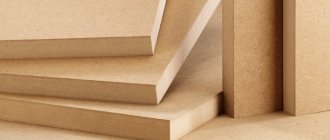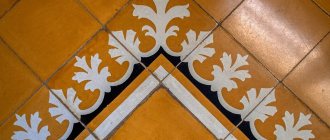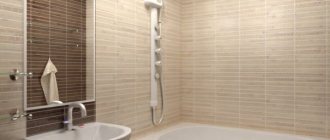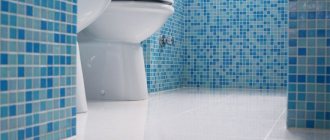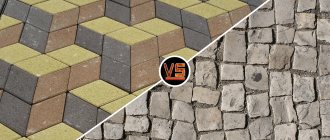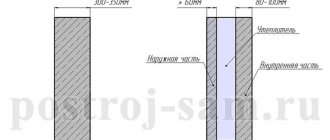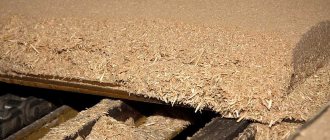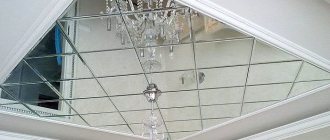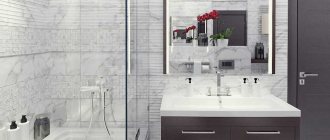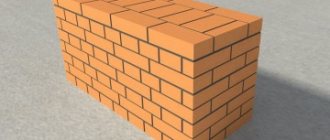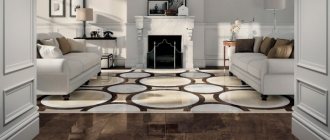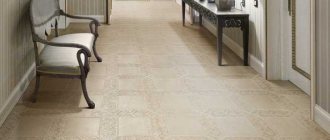What is the thickness of ceramic tiles?
The thickness of ceramic tiles is an important parameter that should be taken into account when choosing material for cladding.
The thickness of the product affects not only the technical characteristics, but also the visual perception. The durability of the material for cladding, and accordingly the wall cladding itself, also depends on the thickness. Thinner tiles are more susceptible to cracking and other destructive influences.
The thickness of ceramic wall tiles is usually less than that of floor tiles. For wall cladding, options with thicknesses ranging from four to nine millimeters are used. The option with a thickness of 7 mm is considered universal, since as the thickness of the product increases, the weight and consumption of glue during installation increases, as well as the cost set by the manufacturer.
What should be the thickness of wall tiles in a bathroom?
The choice of the thickness of the cladding layer for the walls in the bathroom is made based on the size of the room itself, which directly affects the choice of cladding materials. It is not recommended to use tiles with a thickness of more than 8 millimeters, but also less than 3 mm. It is worth remembering that as the thickness of the product increases, not only its strength increases, but also its cost.
Thickness for floor
Ceramic floor tiles are usually much thicker than wall tiles.
This is due to the fact that the tiles on the floor take up a large load, and therefore require certain strength qualities, which are determined, among other things, by the thickness of the product. Common average values include a range from 6 to 12 millimeters of thickness.
However, variations of products with thicknesses from three to twenty-five millimeters are known. On sale, as a rule, it is difficult to find options thicker than 12 mm in thickness, but for ordinary apartment and house needs, more is not required.
Tile thickness depending on type and conditions of use
The thickness of the tile largely depends on the type of material and its scope of application. That is why, when choosing, you should definitely take this parameter into account.
The thickness of floor tiles may vary
Table with comparative data of porcelain stoneware and tiles
Tile
Laying tiles on a wall, floor or ceiling is not difficult if you delve into the details of the process. But such a parameter as the thickness of ceramic tiles needs to be given great attention during repairs. This is an important point that determines the strength and durability of the tile covering. Please note that products from different brands have different thicknesses. Moreover, the range of variation in this category is quite wide. Thus, the most common option is considered to be tiles for household use with a thickness of 4-9 mm. And the rarest are models for organizing flooring in industrial buildings, the thickness of which reaches 250 mm.
Experienced builders will tell you that the larger the parameters of the tile, the thicker it will be. Too thin options demonstrate low strength properties in terms of impact resistance of the coating. But the thicker the material, the more expensive it is. Therefore, the price of ceiling tiles is often the lowest size, and the price of floor tiles is the highest.
Experts in the field of residential finishing recommend carefully studying the packaging of wall or floor cladding before installation begins. As a rule, manufacturers of tile material indicate on it the recommended thickness and type of adhesive with which the material is fixed to the surface.
This indicator must be adhered to. Then the floor covering will be not only aesthetically attractive, but also strong, durable, resistant to mechanical stress and practical. After all, wall tiles must be securely fixed to the wall surface and have high resistance to external influences: impacts, high humidity, and so on.
Laying tiles on the floor requires a thicker layer of adhesive
Floor
In this case, the minimum layer is 8 mm. It is used exclusively for organizing flooring in rooms where traffic is very low. After all, such floors will not be sufficiently resistant to high loads, so they can quickly become unusable. The thickest option is a coating with a thickness of 12 mm. It is very durable and resistant to mechanical stress. At the same time, this is a very expensive floor finish. And due to its high cost, it is not worth using it for domestic purposes.
12 mm is the maximum thickness that can be found on the market
So what thickness is optimal for a tile floor? This parameter for floor tiles in a city apartment or country house ranges from 9-11 mm. Such floor finishing will be affordable, durable, and practical. And if you pay due attention to its installation, it will last a long time.
When using floor cladding, the thickness of the adhesive is selected as follows. Based on floor defects, the current volume of adhesive composition is changed. So, with a perfectly flat field, the glue layer should be 4 mm, and if there are small irregularities on it - 9 mm. If the tile parameters exceed 300x300 mm, then the thickness of the adhesive composition should be 7 mm.
The thickness of the tile determines its mechanical and physical coefficients and affects the strength of the base
Wall-mounted
This parameter for ceramic materials for walls is lower than for floor products. It varies from 4 mm to 9 mm. This finish will have an acceptable level of durability. Thicker slabs are not suitable as wall cladding, because they increase the weight of the finish and complicate the technology for its implementation. More glue is needed for installing heavy tiles, and there is no guarantee that it will last a long time without loss of quality.
For wall work, the thickness of the adhesive is from 3 to 5 mm and is determined by the presence of surface defects, as well as the weight of the tile. More massive options require a thicker layer of adhesive. Then the floor will be truly durable and resistant to stress.
Laying tiles on walls is done from bottom to top; the thickness of the adhesive for standard wall tiles is 4-5 mm
Ceiling
The specificity of ceiling tiles is that they are influenced by the force of gravity to a greater extent than wall options. In other words, such finishing needs to ensure a more reliable fixation on the base. This is possible if the cladding is light in weight and done using reliable adhesive. And it is this fact that explains why manufacturers of ceiling tiles often make them much thinner than wall cladding can be. Thickness for different types: for extruded tiles from 2.5 to 3 mm; from expanded polystyrene from 9 to 14 mm.
Ceiling tiles
Laying tiles with your own hands
As a rule, the amount of work involved in tiling the kitchen walls is small, and the actions themselves are not particularly difficult and are accessible to almost everyone. By doing the work yourself, you can save on hired labor and, accordingly, afford expensive Italian or Spanish ceramics.
When choosing tiles for the kitchen, you should be especially careful, since not all tiles will be combined with the configuration of the kitchen cutting table and wall cabinets
However, before laying 10x10 tiles, you need to perform a number of preliminary steps:
- It is necessary to decide on the design of the kitchen, the location and quantity of kitchen furniture in order to make the most of the functions of all elements. It is necessary to decide whether the kitchen will be a place for eating or just a place for preparation.
- Carefully select and select furniture, calculate the dimensions, and accurately note the height at which it will be hung. It should be remembered that the chosen kitchen interior will exist for many years.
- Select the type of tile, calculate the size and quantity. You need to take a reserve of 10-15%, taking into account breakdowns; the remainder can then be returned to the store or left for partial repair of damaged areas.
- After this, carefully outline the area of the apron, making sure that its boundaries are exactly horizontal.
- The wall under the tiles must be perfectly leveled, plastered and treated with grout.
You can tile your kitchen splashback yourself
If the interior partition is made of wood (which happens in houses built in the 1960s), then it is recommended to break it, replacing it with cinder block, or cover it with gypsum fiber board wall panels without demolition.
Ceramic tiles 10x10 are laid with a special adhesive, which allows them to be rubbed into the wall for some time after installation. The adhesive layer applied to the back of the tile is leveled with a special notched trowel. The coating is laid layer by layer, from bottom to top, the seams are marked with special crosses.
After the glue has dried, the joints are treated with a grout mixture, and the tiled wall itself is washed and wiped with a dry cloth.
How many pieces of tiles are there in a square meter?
Ceramic tiles can vary in size.
In order to calculate the number (in pieces) of tiles of one size or another per square meter, you need to calculate the area (quadrature) of one tile and then divide the square meter by the area of one tile.
Here is an example, 20x30 tiles.
Area is length times width.
It’s more convenient (to avoid confusion in the future) to immediately convert centimeters to meters.
20 cm = 0.2 meters, 30 cm = 0.3 meters.
We multiply 0.2 x 03 = 0.06 meters - this is the area of one tile.
Divide 1. 0.06 = 16.6 (with a tail, can be rounded to 16.7).
As a result, we get the required number of tiles measuring 20 x 30, 16.7 pieces in one square meter.
Using the same principle, the quantity of any size tile is calculated.
And more information from personal experience, on the container (box)
There is information both in square meters and in the number of pieces in a box, as a rule, one package contains more than one square meter (1.2, 1.5, etc.).
Tiles are almost never counted in pieces (the frieze or decor is counted by piece), but tiles are counted in square meters.
the moderator chose this answer as the best
To order tiles, it is enough to know how many square meters of surface you will cover. It is necessary to understand that it is quite simple to abstractly calculate the number of tiles per m2, but in reality, in order to lay a specific m2 of tiles, more than the calculated value may be required.
There is no need to find the area of 1 piece, then how many pieces will be in 1 m2 and, finally, in the quadrature you propose. It is enough to simply divide the quadrature you declared into length (in meters) and width (in meters):
3/0.3/0.3=33.33 pieces of tiles measuring 30x30.
2/0.4/0.2=25 pieces of tiles size 40x20.
But, this is if you just lay out the tiles on a flat surface. When carrying out actual tile repairs, more may be required because the proportions between the size of the tile and the size of the room are not respected. If you divide the length of the wall by the length of the tiles (taking into account joints and corner joints), you will not get a whole number, which means that the tiles will need to be cut. So, a margin of up to 15% will not be superfluous.
I must say right away that the calculation is very simple (from the initial geometry course).
You need to know the size of the tile. By multiplying the height by the width, you get its area.
At the same time, convert (to avoid confusion) centimeters into meters (divide by 100).
In your case, the area is 1 piece. tiles will be:
- in the first case - 30x30 cm or 0.3x0.3 = 0.09 m2;
- in the second case - 40x20 cm or 0.4x0.2 = 0.08 m2.
Now all you have to do is find out how many pieces of tiles are in 1 m2. To do this, simply divide 1 m2 by the area of 1 piece. tiles of each size, which will be:
And multiply by the area of the laid surface:
What sizes are ceramic floor tiles?
When considering the size of ceramic tiles for floors, it should be borne in mind that the choice is made based on certain criteria, for example, the size of the room. The most universal option is a ceramic floor covering with dimensions of 20 by 20 centimeters in each piece. Among other configurations, the following options in centimeters can be noted:
- 10x10;
- 10x20;
- 15x15;
- 30x30.
There is a pattern that the smaller the dimensions of the tile, the greater its resistance to fractures.
For kitchen
Covering kitchen walls with ceramic tiles is a budget-friendly and reliable option to add comfort and coziness to the room without losing its aesthetic qualities. Traditionally, small tiles are used for the kitchen, especially if the room itself is not large. The recommended thickness is 5 mm; you should also ensure that the surface of the product is covered with a protective layer of enamel, which will protect the lining from all kinds of kitchen contaminants.
For bathroom
In the case of a bathroom, the dimensions of the tiles play a big role. The choice of tile sizes is carried out, first of all, based on the size of the room itself.
Ceramic cladding for a bathroom should match the area of the room. If this is a small room, then the cladding should be made of small fragments to create a visual feeling that the room itself is larger. Accordingly, the larger the area of the room, the larger the size of the cladding particles used.
Rectangular ceramic tiles with a format of 20x25 centimeters, as well as 20x40 and 20x60, are often used in bathrooms. By orientation, they can be located both vertically and horizontally.
More is not better
When choosing a finishing material, there is a great temptation to buy a larger size: they say, less needs to be glued, less hassle. However, keep in mind that the larger the element, the heavier it is, which means there is a high risk that the coating will “float” when gluing. Therefore, for wall tiles there is a thickness limit - from 4 to 9 mm. Accordingly, the thicker the tile, the smaller its area.
Bedroom walls: 5 decorating tips
If bedroom walls could talk, what would they say? Perhaps: “We can hear the neighbor's TV at two in the morning” or “This shade of paint in the morning light looks different from the manufacturer's sample”? We are talking about finishing solutions that will definitely suit the walls in your bedroom.
Another nuance should be taken into account when gluing: the thickness of the adhesive layer. Beginners often believe that the more glue there is, the better it will stick. However, this leads to the fact that the adhesive does not adhere well and the tiles slide off, despite the “crosses”. This is especially offensive when laying out mosaics or complex figures. The optimal amount of solution is from 4 to 8 mm, depending on the size and weight of the panels.
How to choose?
The choice of material depends on a number of factors.
Let's list the main ones:
- The material for wall cladding is also not intended for floors, just as floor tiles are not suitable for walls: failure to comply with this criterion will complicate installation and reduce the durability of the coating.
- Raw materials are purchased by making a preliminary calculation, adding several pieces to the resulting number of fragments (defects cannot be ruled out during the work process).
- Color matters: it should fit into the overall picture of the room without interrupting the main background of the interior.
- When choosing a design, take into account the size and theme: a small print against the general background creates ripples (checks, stripes, matting are better replaced with abstract patterns).
- Laying the surface in a single color is good for the floor; for walls, an accent is needed: it is worth buying a companion with a pattern for the material.
- If possible, it is necessary to perform calibration before purchasing: if the thickness and perfection of the corners leave much to be desired, this material is not suitable for the job (the surface of the finished canvas may differ in level).
- Each type of raw material has its own classification, which is indicated on the packaging. Try to choose a product with a red mark: these tiles are durable and practical.
- It makes sense to choose practical material: priority is given to surfaces with an interesting texture and pattern. This is not necessarily a motley pattern: an imitation of texture (stone, brick, wood, parquet) looks better.
- Avoid complex patterns: they tire your eyes. To evaluate the perception of the material, while in the store, put several tiles together and step away: you will see the advisability of purchasing this variety.
- Buy material with glaze. It adds strength to the coating and extends the life of the material.
Optimal sizes for different rooms - how to choose
Rooms intended for finishing can have very different dimensions, which should be taken into account when choosing the size and shape of the tiles. Properly selected tiles can visually change the space. With its help, you can expand the room, “stretch” the height of the walls, and designate individual zones using wall borders. To visually raise the ceiling, you can lay tiles measuring 20x30 cm vertically.
You should not choose large tiles with a size of 50x50 for a small room. The only exception is a visually monolithic porcelain stoneware coating with invisible seams. Therefore, it is better to look in catalogs for popular small-sized products or mosaics.
For bathroom and toilet
When choosing cladding for your bathroom, we recommend following these tips:
- For walls, choose a standard glossy finish, and for floors, matte;
- Place darker material on the floor and lower half of the walls. It is better to decorate the upper part of the walls and ceiling with light wall and ceiling tiles;
- the bathroom or shower area should be highlighted in a color contrasting with the main tone;
- tiles with large convex reliefs are best used as decorative fragments.
Uneven edges will be difficult to join in the corners.
Large tiles on the walls in the bathroom do not look impressive. It is inappropriate here, it will have to be divided, and besides, due to its large format, problems may arise with installing plumbing hatches under the tiles. It is better to use dimensional products for finishing the floor, and suitable sizes for walls are 45x20, 50x20, 50x25, 60x30. The cladding looks aesthetically pleasing when there are no more than 6 fragments along one wall. Based on this advice, you can choose products of suitable width.
For kitchen
When decorating a kitchen, not only the shape, color, texture, but also the size of the tiles are of particular importance. It can be different - from mosaic squares of 1x1 cm to impressive slabs of 60x60 cm. The walls are most often lined with glazed square elements, which visually expand the space thanks to the glossy surface, with a side of 15 cm. Options with dimensions of 30x30 and 40x40 and 20x30, 30x40 are also common. Large tiles are not the best option for walls, since they are quite difficult to install. It is better to cover the floor with large slabs. This will speed up the installation process and minimize the number of seams.
For the floor, slabs with parameters 30x30, 40x40, 50x50 or 60x60 are suitable. If you plan to use a mosaic, choose one that is glued to square polyurethane or paper backings.
You can stick artificial stone bricks with dimensions of 9x15 cm or tiles with various patterns of 10x10 cm or even smaller on the walls. Such products will help highlight a fragment of the wall and create an atmosphere of antiquity.
Porcelain stoneware slabs are more than appropriate in the kitchen - glazed for the walls, matte for the floor. The most popular products are with dimensions 30x30. The remaining options - from the smallest - 5x5, to 100x100 and 120x180 cm, are also in great demand.
For the hallway
The dimensions of the slabs influence the design of the hallway. If the size is poorly chosen, even the most spectacular tile will not look presentable. For a small space it is better to choose small and medium modules because they:
- look organic;
- easier to install;
- will require less pruning.
Pros of large tiles:
- For a large room, large-format tiles are the best option. Installation is much faster. Large plates help maintain surface level and minimize the number of seams. Debris often gets clogged in the spaces between the tiles, causing mold and bacteria to form.
- Also, in large halls, a composite panel of tiles in the form of a carpet will look very colorful.
- Mosaics should not be used on the floor - they are more suitable for wall decoration. It is better to choose square and rectangular slab options. Octagonal tiles with eye-catching gold or silver accents will look great.
Floor tile size
It is important to know that the sizes of floor tiles are different from the sizes of wall tiles. So the thickness of the floor tiles does not exceed 0.7 cm, and the thickness of the floor tiles is equal to or more than 0.9 cm. The sizes of porcelain floor tiles vary from 2.5x2.5 cm to 60x60 cm. For a small bathroom they choose up to 40x40 cm. However, more and more often people prefer laying ceramic slabs of non-standard sizes (36.5x12 cm) with parquet imitation.
For small bathrooms, the most preferable option is medium-sized tiles
The floor size is 600x600 mm and is easier to install. However, porcelain tiles of this size are not suitable for a small bathroom. This is due to the cutting of porcelain tiles, which does not look aesthetically pleasing. Also, a large product is much more expensive than a small product. Before laying, it is necessary to carefully level the base, otherwise all deviations of the floor after cladding will be visible.
You should be very careful when ordering individual tiles: the dimensions may differ greatly from those stated by 5 mm or more. This is due to the individual behavior of the clay during firing. However, this deviation is often leveled out when laying ceramic tiles.
Ceramic tiles are not always laid on the floor. Rubber has a number of advantages over ceramic or PVC. It is cheap and widely available, made from fractional crumbs of car tires. Due to synthetic and natural rubber, rubber tiles are elastic, durable and strong. The most common product size is 35x35 cm.
Thanks to its properties, rubber tiles reduce the risk of slipping on wet bathroom floors. Therefore, more and more often they are setting up an area near the pool. The rubber plate is soft and rough. It is used as both floor and ceiling cladding. Often the rubber lining looks decent. It is soft and rough, with its help you can not only change the interior of the bathroom, but also provide good adhesion.
Rubber floor tiles
Rubber tiles have noise-absorbing and damping properties. It will not crack, get wet or fade. It can be decorative, because manufacturers provide their customers with a wide range of slab colors. If installed correctly, you can change the interior of your bathroom for many years. It is used both as a wall, floor and ceiling slab, since it is lightweight and easy to install. Even with ceiling masonry, professional skills are not required.
PVC slabs and panels are also used for the floor. However, this type has more disadvantages than the rubber one. PVC panels are easy to install and clean. But the variety of colors of this finishing material is small. PVC boards are easy to damage. In addition, if the panel is not fastened correctly, fungus may develop in the area of the walls and ceiling of the bathroom.
Self Adhesive Vinyl Tiles
Selecting the right vinyl tiles will allow you to install them as airtight as possible. In addition, PVC flooring is used to cover “warm floors”.
Installation of vinyl finishing materials on the bathroom floor should only be carried out on the sheathing, which will occupy at least one and a half cm between the heating system and the cladding.
Optimal size of notched trowel
Notched trowels are commonly used for laying ceramic tiles. Thanks to this tool, the glue is applied in waves, so the excess does not protrude beyond the boundaries of the tile area.
To achieve this result, the spatula must be selected according to size. Ideally, the width of the tool should be equal to the sides of the tile, or slightly greater. It remains to determine the size of the comb teeth. For tiles of any shape other than square, you can use the following diagram:
Tile area 50-100 cm2 – tooth size 4 mm.
Area 100-400 cm2 – size 6 mm.
Area 400-900 cm2 – size 8 mm.
Area 900-2,500 cm2 – size 10 mm.
For uneven bases and floor coverings, the size of the teeth may vary larger.
Side size of a square tile (when using rectangular tiles, the calculation is based on the area - see above)
Recommended spatula tooth size
To properly lay ceramics, you must follow the following technological process:
Work always starts from the far corner and is carried out towards the door.
To simplify the process, it is recommended to install beacons and make markings.
In uneven corners, tiles can be laid through a special plastic corner, which partially compensates for surface errors.
At the final stage, the base row is laid out, which levels out all the unevenness.
After laying the tiles, the gaps are filled with grout mixture.
Dimensions of wall tiles
When installing vinyl wall tiles, the use of connector moldings is not required. In addition, thanks to the laying of such facing material, easy access to technical communications is maintained. The surface of the material is non-slip compared to ceramic.
Among the advantages of PVC panels and slabs are noted:
- moisture resistance;
- when laid correctly on the walls, it is visually difficult to distinguish from ceramic;
- cheap material;
- can be marble, wood or stone in color;
- PVC is an environmentally friendly material;
- The laid white PVC tiles on the ceiling look good and do not allow moisture to pass through.
PVC ceiling, wall or floor tiles must be laid on the sheathing. In the bathroom, each wall will become smaller by approximately 4 cm. This should be taken into account by owners of small bathrooms.
Tiles 15 x 15 cm - the best choice for the bathroom
The standard for wall cladding is ceramic products. You can use mosaics, small tiles from 2.5x2.5 cm, 33x33 cm and larger. For a large bathroom you can choose absolutely any tile, but for a small one it is better to use a small one.
It is worth noting that ceramic products are the standard for finishing walls, floors and ceilings. Most often, white or any light color is laid on the ceiling and walls, and dark on the floor. You can decorate the wall with slabs with a pattern or pattern. Finishing material of marble, wood or stone color can be laid on the floor and walls; these slabs imitate the texture of natural materials. Only, unlike a marble slab, a ceramic one is lighter and cheaper.
Tiles 10 x 10 different colors
Tiles with dimensions of 15x25 cm, 20x25 cm are suitable for small bathrooms. Khrushchev's houses usually have small bathrooms. Floor tiles can be larger in size, however, it is better to choose them in proportion to the wall tiles.
For larger bathrooms, ceramic finishing materials measuring 33x45 or 30x60 cm are used. These are the most common dimensions of ceramic slabs.
Types and sizes
Tiles can be of different sizes, both small and large. The main mistake when renovating a bathroom is choosing too large slabs that have to be divided. Not everyone knows that for wall cladding you need to select products of such a width that at least 6 pieces are located along one wall. Then the walls will be more aesthetically pleasing.
| Bathroom slabs | |
| View | Size, cm |
| Standard rectangular | 15x25, 20x25, 33x45, 30x60 |
| Square ceramic | 2.5x2.5, 5x5, 10x10, 13x13, 20x20, 30x30, 40x40, 50x50, 60x60, 60x120, 120x120, thickness from 0.3 to 3 |
| Marble colored slabs | 20x30, 30x30, 31.6x31.6, 33x33, 38x38, 40x40, 44x44, 50x50 |
| Rubber | 35x35 or 50x50 |
| PVC | Minimum 45.7x45.7 |
| Foam ceiling | Thickness of extruded – 0.6-0.7, injection – 0.9-1.4 |
| Artificial stone slabs | 44x44, 44x66 |
| Polymer sand | 3.3x3.3, thickness varies from 1.8 to 3.5, slabs of minimal thickness are used for the bathroom |
Tile size
How to choose kitchen backsplash tiles
Places that are maximally splashed with water, fats, and where soot settles (working area of the wall) must be decorated with a tiled apron. This makes it easier to care for the surface and adds decorativeness to the decoration of the room.
When deciding which tile to choose for the kitchen backsplash, take into account the resistance to acids and alkalis. In the work area, detergents are most often used for cleaning. The backsplash tiles should have a dense enamel coating and minimal porosity. Look at the labeling - the highest level of resistance to aggressive chemicals is indicated by the letters AA.
There are no mechanical loads, so strength indicators are not important here
Better pay attention to the heat resistance of ceramics
It is especially important for owners of gas stoves: high-quality glazed tiles will withstand heating up to 125°
The fashionable modern trend of finishing walls with small-sized tiles has been criticized due to the large number of grout joints. This is where all the germs and kitchen dirt gather, which makes cleaning difficult.
Pay special attention to the choice of grout. To prevent it from darkening and to look neat for a long time, moisture- and dirt-repellent components and antifungal fillers are added to the material
Along with discussing how to choose kitchen tiles for a backsplash, think about the problem of untidy seams. It is solved by evenly cut (rectified) tiles, when laying the distance between the edges does not exceed 2 mm.
Types of ceramics for an apron
- Popular size is 10x10. Rarely requires trimming, convenient for installation in hard-to-reach places, and easily combined with decor. The disadvantage is a lot of seams. Manufacturers imitate 10x10 tiles by offering large tiles in multiple sizes with indentations.
- Brick-like ceramics. Rectangular in shape, beveled edges, usually plain. Calm colors are suggested to be diluted with decor with photo printing. Visually expands the room.
- Mosaic tiles. Mosaic looks great, is tricky to install, and requires maintenance. Let's replace it with a more practical imitation, tiles with deep “mosaic” slots, which are easier to lay.
- Medium format ceramics rarely end up on the backsplash. Often requires trimming and is difficult to fit into dimensions.
Apron decor
- Insert tiles are common and convenient. They have dimensions that match the dimensions of the base. The choice of patterns is huge; such decor can be placed scattered or in the form of panels, in accordance with the design idea.
- A panel in the form of a large tile or a picture made up of four to six small tiles.
- The frieze consists of rectangular decorative tiles, laid out as a border along the perimeter of the upper, lower edges, and in the center.
Designer tips for designing a kitchen apron
- Adhere to harmony; the design of the tiles for the backsplash echoes the design of the kitchen, the “appearance” of the kitchen set, and the flooring;
- The white color of the tile is universal and matches almost any color. Dilute the whiteness with colored inserts, decor, mosaics;
- play with contrasts between the colors of the apron and furniture;
- bright, variegated colors, large patterns - for large spaces, a small kitchen will seem even cramped;
- Large tiles are not suitable for a small room;
- dark gloss visually narrows the space, beige, cream, sand shades expand it;
- practical shades for a kitchen apron - in beige and brown tones, the least branded.
Shapes of tiles and their combinations
The best visual result is obtained when a combination of different colors, textures and shapes is used in the cladding. For example, the current top-end “hog” will make the interior somewhat heavier if you use it to decorate a bathroom from floor to ceiling. Therefore, it is recommended to alternate it with a contrasting finish of another kind - for example, painting or artistic plaster.
The same goes for mosaics. At the same time, both the “hog” and mosaic masonry will look impressive as a kitchen apron, setting off the dense panels of the kitchen set.
Determining quality
The performance characteristics of a good kitchen tile should be high. Choose ceramics that are resistant to dirt, abrasion, aggressive detergents, and hot steam.
In a work area decorated with an apron, the walls are always subject to heavy grease contamination, so the tiles here should be covered with an additional layer of enamel.
Pay attention to medium-priced tiles; in this segment it is possible to choose high-quality material without overpaying for a well-known brand. Do not overdo it with savings - you risk purchasing a fragile, low-quality product
Purchase facing materials in specialized stores. A variety of textures, colors, styles will satisfy every taste. Sales consultants will professionally advise which tiles to choose for the kitchen. Plus, get a guarantee of return of low-quality material.
Application of foam plastic
Repair will not be a difficult process if you choose foam boards. As a rule, light colors are chosen for the ceiling. Or shades of blue, beige. White material is cheaper, but looks noble and fits into any interior. It is not placed on the floor or walls. This is explained by the high moisture absorption of polystyrene foam and its fragility. Ceramic granite slabs designed to look like stone are used as flooring and wall coverings. Decorative designs enhance the space.
The installation of foam tiles should be approached with extreme caution due to its fragility. The use of water-based paint will significantly increase resistance to moisture, which is always a lot in the bathroom
The thickness should not be chosen more than 7mm
It is important to remember that it is not advisable to wash or wipe foam products
Which tile is suitable for the bathroom, sizes, pattern
Most often they use a mosaic texture, which is made in sheet form. Sizes from 30x30 cm and above. The mosaic pattern can be mirrored, made to look like artificial stone, marble, metal, glass. If tiles are chosen for the floor, then it is best to choose a non-slip material. We should not forget about the need for access to communications. For this purpose, bathroom hatches for tiles are used, the dimensions of which must correspond to the laid squares or rectangles.
Polymer sand tiles are most often used when laying sidewalks. Some people like this finish, or a similar one, as a bathroom decor. This type of cladding can be imitated using special painting.
You can also achieve an imitation of marble and granite. It is clear that natural stone is very expensive, but the same effect can be achieved by using ceramics with the desired pattern. Visually it looks rich and unusual.
It is not necessary for the cladding to have a cold marble shade. The light beige coating looks very good. It gives the bathroom coziness and warmth. Light colors are suitable for the ceiling. It may be bluish or white. In the case where the room area is small, the floor should be dark shades like artificial stone or marble.
When materials with imitation marble or artificial stone are used in decoration, the bathroom is transformed and takes on a stylish look. Standard sizes of bathroom tiles allow this to be done. A design solution will help not only in choosing sizes and colors, but also in the direction of installation. It can be changed relative to the walls. All this will add unusualness and originality to the bathroom.
You might be interested in:
Best Bathroom Tiles: Top Ceramic Bathroom Tiles
How to remove silicone sealant: removing silicone from bathroom tiles
Tile shower tray: how to make it yourself?
Paint for bathroom tiles: what is the best paint?
Ceramic border for the bathroom: examples in the interior
How to choose tiles for a small bathroom: useful tips
Ceramic corner for the bathroom: covering the corners of the tiles
Which tile is better to choose for a bath
Rubber tiles for flooring
The product has noise-absorbing properties. It is not exposed to high temperatures, does not crack, does not get wet and does not fade. They produce tiles in various colors and patterns. With its help, you can change the interior appearance of your bathroom or bathroom for the better. It can be easily installed on the floor, walls and even the ceiling. Easier to install than any other material.
Also on topic: Which tile is better to choose for a bath
In addition to rubber coating, PVC tiles are used. These panels are also easy to mount on a surface. They wash well and look good. But PVC products do not have the same color range as the previous material. In addition, they are susceptible to mechanical damage. In case of inept installation, conditions for the development and spread of fungus can be created.
Bathroom wall tile sizes
Installation of vinyl cladding on walls does not require the use of moldings or other means. In addition, the use of this lightweight material ensures accessibility to technological communications. The surface of vinyl products is rough and does not slip like ceramics.
The main advantages of PVC panels:
- resistance to moisture;
- visually no different from ceramics;
- relative cheapness;
- painting like marble, wood, stone;
- environmentally friendly;
- The cladding looks decent and is resistant to moisture.
PVC tiles can be mounted on the floor, walls or ceiling using lathing. In the room, each wall will be reduced by 4 cm. The dimensions of bathroom tiles are most optimal at 15x15 cm. In most cases, ceramic products are considered the generally accepted standard. It is possible to create mosaic paintings from small tiles of 2.5x2.5 cm. But more often 33x33 cm or more are used. Any size looks good in a spacious bathroom. Small squares are placed in small rooms.
Ceramic is considered the standard cladding for walls, ceilings and floors. As a rule, dark colors are laid on the floor, and light tiles are used for the walls. The surface decorated with a patterned pattern looks good. And ceramics with a wood texture, designed to look like stone, marble are often placed on the floor, the lower part of the wall.
Products 10x10 cm are best suited for decorating bathrooms. Standard sizes of bathroom tiles range from 33x45, 30x60 cm.
Ceiling tiles
Covering the ceiling with PVC material should take into account the further installation of ventilation and lighting systems. Dimensions can be 30x30 cm. The thickness should not be chosen more than 7 mm. The panels are secured with self-tapping screws or dowels.
RESULTS
ROOM
RESEARCH (3203) RESEARCH (1694) RESEARCH ASSURANCE °Â (3570) ROYAL (1898) ROYAL (1003) ROYAL (894) 147) ROCK (272) ROCK (239) ROCK SAL (242)  (352) ROOM (20) ROOM °S ÐÐ»Ñ Ð´Ð°Ñи (495)
РекомендÑем
REPORT (74) REPORT RESEARCH (1191) RESEARCH -лиÑÑ Ð¥Ð¸ÑÑ Ð¿Ñодаж (42) овинки (107)
RESEARCH
RESEARCH (880) RESEARCH  (494) ´ÑÑевой комнаÑÑ (3271) РкоÑидоÑ (444) ШеÑÑигÑанн RESEARCH (122) RESEARCH ¸Ñка (45) ÐлиÑка кабанÑик (88) ÐÑÑмоÑÐ³Ð¾Ð»Ñ½Ð°Ñ Ð¿Ð»Ð¸Ñ ROYAL (1174) ROYAL ROOM (132) ROOM (96) ROOM ·Ð°Ð¸ÐºÐ¸  (414) PARK (275) PARK (511) CLASS (370) CLASS ¾Ð»Ñ (352) ÐÐ»Ñ RESEARCH (272) RESEARCH (1123) RESEARCH RESEARCH (1481) RESEARCH RUR (246) RUR (22) RUR (89) RUR (108) RUR RESULTS (810)
RESPONSIBILITY
10×10 (113) 10×20 (124) 10×30 (110) 15×15 (118) 15×40 (5) 15×60 20×20 (246) 25×25 (46) 20×30 (176 ) 20×40 (76) 20Ñ44 (34) 20×50 (143) 20Ñ60 (303) 20Ñ80 20Ñ120 25×40 (145) 25×50 25×75 30×30 (1021) 33×33 ( 241) 30×60 (431) 40×40 (319) 42Ñ42 (144) 45×45 (534) 50×50 (102) 60×15 (89) 60×60 (747) 60Ñ120 80×80 80×160 ½Ð¾ÑоÑмаÑна SA (1167)
ROOM
RUR (1565) RUR (2715) RUR (97) RUR (80) ЧеÑно-белÑй (159) ФиолеÑовÑй (78) ол SÑбой (512) RоÑиÑневÑй (1889) RÑаÑнаÑ (219) RÑанжевÑй (94) (54) (2180) (2180) › (246) › › › › ) RO" (311) RO" (270) RO" ROOM (81) ROOM (688) ROOM (111)
ROOM
ROOM (105) ROOM (12) ROOM (136) ROOM SMALL (421) ROYAL (435) ROYAL ´ÐµÑево (586) каменÑ (905) од наÑÑÑалÑнÑй кам ROOM (895) ROOM (72) ROOM (285) ROOM (10) ROOM (34) ROOM RESULT (48) RESULT ( 175) ROOM (133) ROOM (258) ROOM (151) ROOM SOL (14) RUR (780) RUR (85) RUR · ROOM (414) ROOM ROOM (11) ROOM (797) ROOM ºÐ°Ñ (154) 3ÐлиÑка
- RESULTS
RESULTS »Ð°Ð¹Ð½-магазине:10Ñ30 по ºÐ¾Ð¹ Ñене Ð¾Ñ 101 ÑÑблей
- RESULTS ROOM CONTENT:
- RESULTS REPORT:
